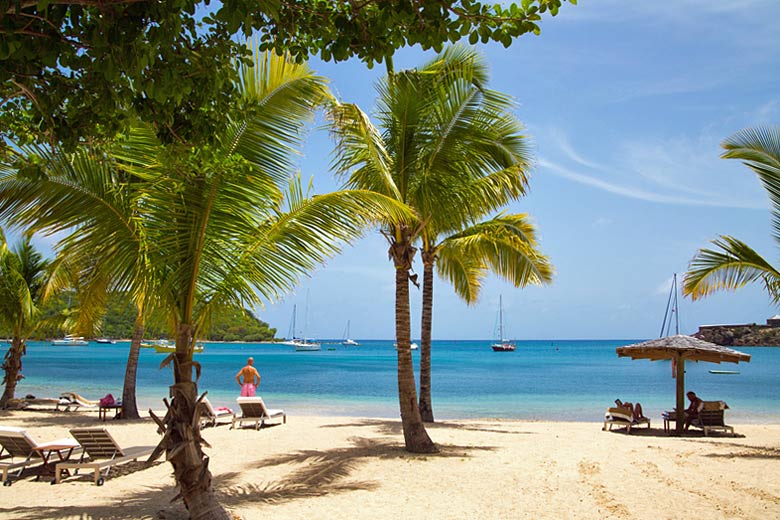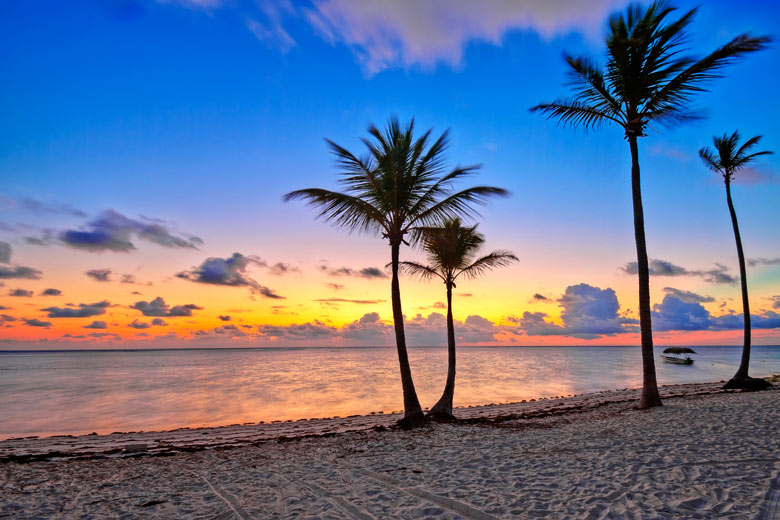- Book online with TUI & save up to 8% on holidays
- FREE child places available for select holidays
- Pay £0 deposits with direct debit & spread the cost
Dominican Republic weather by month
Check out the Dominican Republic weather averages by month. Compare detailed monthly climate statistics including temperature, rainfall and sunshine figures.
| Jan | Feb | Mar | Apr | May | Jun | Jul | Aug | Sep | Oct | Nov | Dec | |
|---|---|---|---|---|---|---|---|---|---|---|---|---|
| Maximum daytime temperature °F |  82 82 |
 82 82 |
 84 84 |
 86 86 |
 86 86 |
 88 88 |
 90 90 |
 90 90 |
 90 90 |
 88 88 |
 86 86 |
 84 84 |
| Hours of sunshine (daily) | ||||||||||||
| Days with some rainfall |  16 16 |
 12 12 |
 12 12 |
 11 11 |
 13 13 |
 14 14 |
 16 16 |
 16 16 |
 15 15 |
 16 16 |
 16 16 |
 17 17 |
| Sea temperature °F |  79 79 |
 79 79 |
 79 79 |
 79 79 |
 81 81 |
 82 82 |
 82 82 |
 82 82 |
 84 84 |
 84 84 |
 82 82 |
 81 81 |
More about the Dominican Republic
Dominican Republic by month
Jan Feb Mar Apr May Jun Jul Aug Sep Oct Nov Dec
Recommended for the Dominican Republic
The climate guide for Dominican Republic (Punta Cana) shows long term monthly weather averages processed from data supplied by CRU (University of East Anglia), the Met Office & the Netherlands Meteorological Institute. Find out more about our data sources.
Top Dominican Republic destinations
Below are average maximum temperatures at popular countries, regions and places in the Dominican Republic for next month - August. Select a destination to see the climate guide for all months of the year.
All Dominican Republic destinations
- Bahia Maimon
- Bavaro
- Bayahibe
- Boca Chica
- Cabarete
- Cayo Levantado
- Cofresi Beach
- Higuey
- Jarabacoa
- Juan Dolio
- La Romana
- Las Galeras
- Las Terrenas
- Luperon
- Playa Dorada
- Puerto Plata
- Punta Cana
- Rio San Juan
- Samana
- San Juan
- Santiago
- Santo Domingo
- Sosua
- Uvero Alto
Metric (°C) | Imperial (°F)
Dominican Republic climate overview
The Dominican Republic occupies the eastern two thirds of the island of Hispaniola in the Caribbean which it shares with Haiti. Its capital, Santo Domingo, is the oldest continuously inhabited European settlement in the Americas, and was the first seat of Spanish colonial government in the New World.
The island is rugged and mountainous and, when Columbus first arrived, was covered in thick forest. Today most of this has been cleared but some pockets do remain particularly in the north-east and on the mountain ranges that run from west to east.
The Dominican Republic is home to some of the finest beaches in the Caribbean, notably on the north coast around Puerto Plata where there is a mixture of resorts and miles of unspoilt shoreline. Scuba diving, kite-surfing and whale watching are popular pastimes around these shores. There are also some very fine golf courses.
The tropical climate of the Dominican Republic is dominated by the north-east trade winds that blow almost continuously year round. Over most of the country, excluding the north coast, there is a rainy season that lasts from May to November. This generally peaks during October when rain comes late in the afternoon in the form of heavy and thundery downpours.
A winter dry season follows, running from December to March. In these months both temperature and humidity are reduced, with 7 to 8 hours of sunshine a day, broken only by a few clouds and occasional showers over the hills and mountains.
The north coast has slightly different weather patterns from the rest of the country because of its direct contact with the trade winds. Most rain occurs later in the year, from October to January, and sunnier, drier conditions prevail during the hotter summer months from May to September. However during this time heat and humidity is generally very high.
Throughout the country daytime temperatures show little seasonal variation from month to month and, even in the rainy season, there is still a considerable amount of sunshine. However because of the high heat and humidity during this time overall probably January to March is the most pleasant time to visit the Dominican Republic. This is also the time for whale watching in the north, particularly in the waters off Nagua.
Hurricanes can strike the island any time between June and November but the chances of this happening are greatest from mid-September to mid-November.
More about the Dominican Republic
Compare Dominican Republic with the UK
Below the Dominican Republic chart shows average maximum daytime temperature for Dominican Republic (Punta Cana) and the UK (London).
Maximum daytime temperature (°F)
Metric (°C) | Imperial (°F)
Compare more Dominican Republic weather >>
Be inspired
Get your weekly fix of holiday inspiration from some of the world's best travel writers plus save on your next trip with the latest exclusive offers
We promise not to share your details
Related posts
Popular travel offers
Explore holidays in the sun for less
- Beach holidays
- Family holidays
- City breaks
- Summer holidays
- Winter sun holidays
- Holiday offers
- Top travel brands
- Airlines & flights
- Discount hotels
- Airport parking deals
- TUI
- Jet2holidays
- easyJet holidays
- Love Holidays
- January sales
Airport parking
- Manchester Airport
- Stansted Airport
- Bristol Airport
- Luton Airport
- Birmingham Airport
- Edinburgh Airport
- Gatwick Airport
- Glasgow Airport
- Newcastle Airport
Airport lounges
- Manchester Airport
- Birmingham Airport
- Bristol Airport
- Edinburgh Airport
- Glasgow Airport
- Heathrow Airport
- Newcastle Airport
- Stansted Airport
- Gatwick Airport














 TUI deal finder
TUI deal finder




